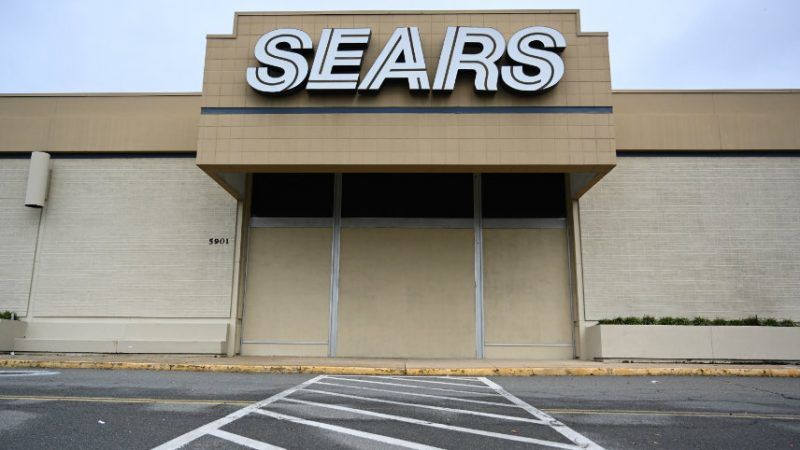Sears Finally Entered Bankruptcy. The Struggle to Save It Was a Noble One.
Sometimes a bankruptcy isn't evidence of some hedge fund manager's hubris or humiliation, but merely a reminder that risk is part of capitalism.

About a decade ago, as I was on my way to meet Edward Lampert for the first time, a friend said to me about the turnaround that Lampert was attempting of Sears and Kmart: "It may fail, but if it does, it will be a noble failure."
Today's Chapter 11 bankruptcy filing for Sears Holdings has generated a lot of discussion, accurate and inaccurate, about the "failure" aspect of it.
But a true account of what has happened requires some notice, too, of the "noble" aspect of it.
For the sake of disclosure, let me state that I know and admire some of the people involved, including Lampert. I am also a Sears Holdings shareholder.
An editorial in The Wall Street Journal described the situation as "a reminder that short-term management rarely prospers" and faulted Sears for failing to "make investments to better compete in the digital era."
That is not at all how I see it. Lampert took control of Kmart when it emerged from bankruptcy in 2003. When Kmart announced its acquisition of Sears in 2004, press coverage described Sears as "broken" and "mired in a retail slump." It is now 2018. That's 14 years (for Sears) or 15 years (for Kmart) of patience and determination and hard work and rigorous analysis trying to rebuild a business that—remember—started out with bankrupt Kmart.
What has happened during those 14 or 15 years? Since 2005, Sears Holdings contributed more than $4.5 billion to fund long-established pension plans supporting Sears retirees whose careers at the company predated Lampert's arrival. That compares favorably to General Motors, which went bankrupt in 2009 after the financial crisis in part because of its obligations to retirees. Sears management also kept open a lot of stores for a long time, hoping they'd turn around along with the economy and the company's transformation. That kept a lot of Sears and Kmart employees working. That was a long-term bet that didn't work out. A short-term mindset would have immediately closed more stores.
As for digital investment, you could pay off Sears' debt if you had a dime for each news article faulting Lampert for spending too much on digital and not enough on remodeling retail stores. Sears Holdings was doing "integrated retail" such as "order online, pick it up at the store," earlier than many of its competitors. Land's End, which was owned by Sears Holdings during much of this period, successfully transformed from a paper catalog and telephone merchant into an email and web business. Sears Holdings developed a "Shop Your Way" platform that allowed it to communicate with customers directly by email and text messages, without relying on newspaper advertising, Facebook, or Google.
Sears Holdings was competing, though, against Amazon, which had no legacy pension obligation and which had the additional advantage of, unlike Sears Holdings, mostly not collecting sales tax.
Plenty of people denounce the labor conditions and market dominance of Walmart and Amazon without doing anything about it. Sears Holdings actually attempted to compete in that retail landscape.
It wasn't out of altruism. If Sears Holdings had managed to succeed better, the beneficiaries wouldn't have only been pensioners and employees, but also shareholders, including Lampert. But interests were basically aligned, contrary to portrayals of Lampert looting the company through "financial engineering."
Lampert could have quit and cut his losses years ago. Some have seen his failure to do so as hubris.
I prefer to describe it as guts.
Restoring venerable brand names to their former glory is challenging and can take more time and money than one plans or has, as I know from my own experience with the New York Sun.
Lampert has put his own money, time, and reputation on the line, for a decade and a half, out of a sense of honor and responsibility to shareholders and stakeholders. Even now he's not giving up, reportedly fending off pressure from banks for a liquidation and insisting instead on a reorganization and restructuring that will allow Sears and Kmart to, as a Sears Holdings press release put it, "save the Company and the jobs of tens of thousands of store associates."
Plenty of investments that might have looked good in 2003 or 2004 didn't turn out so well in the end. Some have even turned out worse than the Kmart debt that Lampert eventually converted into post-bankruptcy control of the company. Lampert and his partners and shareholders have come away not with nothing but with shares of other entities, such as Land's End, Sears Canada, and Seritage Growth Properties, that they have had the opportunity along the way to either sell or keep.
As outcomes go, it's obviously not the one Lampert or his shareholders would have preferred. But the story isn't over yet.
However it does eventually end, there will be a temptation to match the business outcome to a morality tale. Sometimes, though, a bankruptcy isn't evidence of some hedge fund manager's hubris or humiliation, but merely a reminder that risk is part of capitalism. There can be virtue in trying something hard even when success, at least by its financial definition, proves elusive.
Ira Stoll is editor of FutureOfCapitalism.com and author of JFK, Conservative.


Show Comments (39)